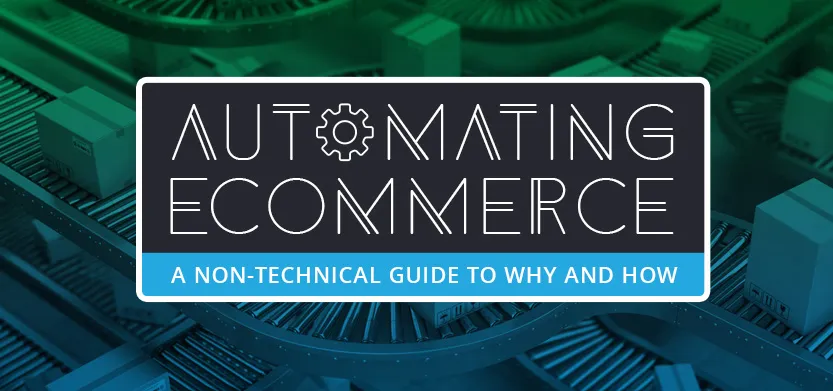
Posted in Automation, Digital Commerce, Software & Development
October 9, 2019
Automating ecommerce: A non-technical guide to why and how
You’ve identified the ideal type of commerce architecture for your ecommerce business and have maybe even gone through initial steps to implement it. You’re now in a position to start making your operations more efficient and scalable. But how do you do this?
I would say one of the most effective ways to achieve this goal is through automation, or, eliminating manual data entry processes. This post will explain why you want to automate your ecommerce operations and how, from a non-technical perspective, this can be done.
Why you want to automate ecommerce business operations
First off I’ll discuss why you want to automate as much of your business as you can. Really, it’s not a hard question to answer. In my opinion, the main reason you should embrace automation is to control your flow of data which helps eliminate human error and reduce operational costs. Plus, it doesn’t hurt that time invested in automation will likely pay for itself. More on that later.
Eliminating human error
The way data is passed around between departments and software is important. Eliminating human error means taking manual data entry out of the hands of humans as much as possible. Software is much faster and more accurate than we could ever be, so utilize it. Taking the human element out of data entry will result in far fewer errors that need correcting and will free up human power for tasks that were better suited for such as complex problem solving, customer service, marketing and creative thinking.
Reduce operational costs
Any processing of data that has been automated will reduce operational costs because fewer people are needed to manage business operations now and as the business scales. In a physical store, more customers mean more staff are required to manage those customers. A digital store doesn’t have the same requirements when steps are taken to automate processes. You may need additional staff in some areas, like fulfilling orders and customer service, but far fewer people are needed to run an efficient online store.
It pays for itself
The goal of automation is to make your business more efficient. If this is achieved, any time and money invested in implementing automation will pay for itself over time because you’re no longer paying someone to do that work. You’ve freed up time and the cost associated with it for those people to do other things.
I have another post titled Eliminating Swivel Chair Processes from your Ecommerce Business that goes over additional reasons why automation is good for your business. If you’re still hung up on why I’d recommend giving it a read.
How to automate ecommerce business operations
Of course, the how is much more complicated than the why. Let’s break it down by implementing business automation into stages. I’ll go over what we would do at Acro Commerce, but you can easily adapt it to your own if you can do the work in-house or are working with another partner.
Discover how your data flows
The first step is to look at your current workflows and processes in order to understand how your data flows right now. As a consultancy and development agency that deals with this type of work, this is part of what we would call a Discovery phase. Here we would have conversations with staff and stakeholders to map out exactly how data is moving from one place to another. This understanding includes what is involved both from a human and software perspective.
Develop an implementation strategy
Once we understand your business and the flow of data, we then move on to a Strategy phase. This is where we plan what we’ll be automating and how it will be done. We now know how the data flows and the processes and software used and can start to see solutions.
Often it’s useful to create visual diagrams of the current system and map out the ideal system. We uncover what modules or software need to be added or removed, whether any custom integrations need to be built, what APIs are available or needed, etc. Sometimes, depending on the work to be done, some rapid prototyping can help take integration or workflows concepts from idea to simulated example. Basically, what we’re doing now is architecting how to effectively use your commerce architecture in a language everyone can understand, whether you’re a business stakeholder or a software developer.
Although we haven’t done any actual implementation yet, discovery and strategy are extremely important phases to do first so that everyone is on the same page. This clarity makes for better dialogue and provides an optimal foundation for a successful design and implementation process. If you’re interested in seeing these phases in more detail, a coworker recently recorded a webinar on the topic that you can watch on-demand here.
Implement the automation strategy
Now that everyone is on the same page and a development automation strategy has been created for your architecture, we can start implementing it. The nice thing about this stage is that the work doesn’t have to all happen at once. Improvements can be incremental and often we’ll start with low-hanging fruit or areas that will have the largest impact. Again, automation pays for itself, so it’s ideal to start with tasks that will see the quickest payback from time saved.
What we mean by implementing the strategy is mainly getting the software components within your business’s commerce architecture to share data and adapting or changing software and workflows to support the automation processes. Examples of this are automatically getting shipping quotes and labels generating, automatically reordering stock at certain levels, passing accounting data from your ecommerce platform to your accounting software, automating promotional emails, etc. There are a lot of possibilities.
Here are some of the ways the implementation of an automation strategy happens:
Adding and configuring modules or extensions
A best-case scenario is when an integration between the systems in your commerce architecture already exists and just needs to be set up. Many popular online business software suites and platforms already have integrations ready to connect them with other popular software suites and platforms. If that’s the case, usually just installing the integrations and configuring them is all that’s required. There may be an additional expense to do so, but typically it’s minimal.
Swapping software components and replatforming
If an aspect of your business is running on dated, unsupported or legacy software systems or platforms, now might be the time to make the switch to something different that will provide more integration and automation capabilities. This is a big part of why you’ve settled on a specific commerce architecture anyway!
Depending on the component or platform being swapped out, this is typically where a business might feel the most pain and possibly incur the most expenses. For example, changing out your ecommerce website platform can be quite costly since a complex data migration will need to be built alongside the setup and theming of your website on the new platform. A more simple change might be swapping out a service used to automate the sending of promotional emails.
A note of caution here, if swapping components means retraining staff or changing workflows, it’s a good idea to get buy-in and approval from these individuals ahead of time, before complicating their life. Make sure they see value in the change, too.
Custom integration development
There may be software that your organization uses that is an absolute requirement and can’t be swapped out with something different. When this happens, custom software development might be what you need to build the integrations that you need.
Ecommerce integrations are a bit of a specialty at Acro Commerce where we’ve built many software connections between various services and platforms. We’ve built integrations with QuickBooks to automate ecommerce bookkeeping, created a web-to-print plugin for integrating Customer’s Canvas into a print shop’s online store, built an integration that allows BigCommerce users to harness the powerful Drupal CMS as their content engine, and we’ve even integrated a legacy ERP system that was a crucial part of one client's operations. Needless to say, if you have an integration to build but don’t have the expertise to do it, we’d love the opportunity to talk to you.
Custom API development
Hand-in-hand with integrations are APIs. APIs, or application programming interfaces, are specific points where data can be transferred between two different pieces of software. They’re added to software to simplify the building of integrations. Most modern software tools and platforms have APIs already built in that can be used, but sometimes an API needs to be added for an integration to be possible. If that’s the case, a company like Acro Commerce can help you there too.
Modifying workflows
Finally, any time software is swapped out or an integration with the purpose of automation has been created, chances are your workflows will also have to change. Obviously, once something has been automated you will no longer need human power to do that same task. Also, changing software may result in different workflow requirements compared to the previous software. In any case, this is part of the changes that will happen while refining your commerce architecture and automating tasks.
As I mentioned earlier, be proactive here with the people that will be affected by the change and be sure to support them with proper training and resources to become familiar with new processes.
Keep on, keeping on
At this point, you’re already in a great spot. Your business is running efficiently, you’re utilizing your commerce architecture to its full potential, and your bottom line is as low as it can be. However, chances are it took a lot of time to get here so don’t be afraid to start the process over and find new areas of opportunity. After all, web technologies are ever-changing and new tools can help you reach your customers better and take your business to reach new heights. You may be running an ecommerce store, but, in a way, you’re also operating a cutting-edge technology company. Keep that in mind and push on further into the future.
Your integration automation experts
Acro Commerce is a digital commerce consulting company that develops tailored ecommerce solutions to help your business succeed in today's digital economy. From discovery all the way to development, our solutions empower retailers by allowing them to adopt or create innovative technology that gives them the freedom to build ideal customer experiences and streamline backend operations. If this sounds like something you need, please get in touch. We would love the opportunity to understand what you need in order to help you achieve your business goals.



